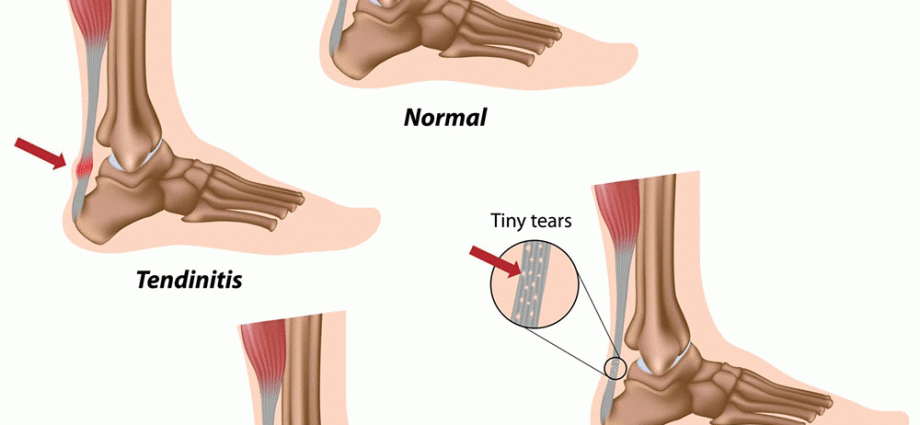Contents
Although the Achilles tendon is the thickest and strongest tendon in the human body, its constant work while walking makes it one of the most susceptible to tendon injuries. Find out the most common causes of an Achilles tendon injury, its symptoms and treatment.
The most common injuries of the Achilles tendon
The Achilles tendon, also called the heel tendon, is a long, thick “cord” running along the back of the leg that connects the calf muscles (gastrocnemius and soleus) to the calcaneus, providing strength to push off the foot when walking, running, jumping, climbing stairs and getting up on tiptoe. Although it might seem that mainly athletes are exposed to this type of injury – nothing could be further from the truth. Achilles tendon injury can affect anyone, including recreational and amateur sportsmen. Achilles tendon rupture / rupture and Achilles tendonitis are the most common pathologies.
Achilles tendon torn or ruptured
A tear or rupture usually occurs in the part of the tendon about 6 centimeters from where the tendon attaches to the calcaneus. Patients typically describe a “popping” sensation at the back of the ankle at the time of injury and experience immediate weakness, swelling, and difficulty walking [1].
This type of Achilles tendon injury usually occurs when performing strenuous activities such as playing basketball, football, or tennis. Bad technique of the exercises, physical activity on uneven terrain or lack of warm-up before training can also lead to excessive overload of the Achilles tendon and, consequently, its tearing. Non-athletes are more likely to damage Achilles tendons by wearing inappropriate footwear, twisting the ankle, or exercising too quickly and vigorously. [2]
Achilles tendinitis
One of the most common ailments is also commonly known as Achilles tendonitis (so-called tendinopathy, degeneration of the Achilles tendon). Achilles tendinitis usually occurs as a result of the gradual wear of the tendon as a result of overstrain or aging. While this may seem like a sudden injury, the tendon is more likely to have weakened over time as a result of the same work activities, routine exercise, and even regular daily activities. [3]
Tight calf muscles that overload the tendon, wearing the wrong footwear while exercising, improper exercise performance, and the presence of a bone heel spur can also contribute to this type of injury. Achilles tendinitis affects both men and women, but scientific research shows that this ailment is most common among men over 30 years of age. [4]
What are the symptoms of an Achilles tendon injury? How does the Achilles tendon get sick?
- burning pain and stiffness along the tendon or back of the heel, especially in the morning – the so-called Achilles’ morning pain
- tendon pain that gets worse during the day
- feeling of rubbing or crackling when you move your foot
- joint swelling
- a palpable lump or thickening in the tendon
- stiffness or pressure at the back of the ankle
- difficulty bending the foot
How is Achilles tendon injuries diagnosed and treated?
To diagnose a tendon injury, an appointment with a doctor is necessary – a specialist will examine you, perform diagnostic tests and ask about your symptoms. They may also order an ultrasound or other imaging test, such as an X-ray of a joint or an MRI scan, to identify the problem, but this is usually not necessary. Most acute and degenerative Achilles tendon injuries can be treated non-surgically. In most cases, non-surgical treatment options will provide significant pain relief, although it may take several months for symptoms to completely resolve. Even with the early application of appropriate treatment, pain symptoms may last longer than 3 months. [5]
Resting is the most important factor in returning to full fitness and stopping the activities that make your pain worse. Depending on the type of injury, the doctor or physiotherapist may recommend relieving the leg (e.g. with a crutch), immobilizing the ankle in plaster (when the tendon has ruptured), performing stretching and strengthening exercises as part of rehabilitation and / or the use of an orthosis. [6]
How to speed up the reconstruction of the Achilles tendon? Achilles tendon and collagen
Collagen is one of the main structural proteins and building blocks produced in the body. It can be said that it acts as a “glue” providing strength and elasticity to tissues – it is thanks to the presence of many collagen fibers that the Achilles tendon is so strong and resistant to stretching.
Supplementation with high-quality liquid collagen can help you recover from tendon injuries. Particularly noteworthy is the Cignon Shots dietary supplement – a modern preparation that provides the main building components of the tendon and participates in the processes of their regeneration and reconstruction. Cignon Shots is recommended not only for people after mechanical injuries and reconstruction of tendons and ligaments, but also for all those who want to take preventive care of the health of their locomotor system.
Cignon Shots contains the most important nutrients necessary to maintain the proper biomechanical properties of the tendons. In addition to collagen, the composition also includes mucopolysaccharides, which help to organize and renew deformed collagen fibers, contribute to the maintenance of the correct shape of tendons, give them strength and resistance to tearing. Their supplementation is additionally justified by the fact that the human body produces mucopolysaccharides only until the end of growth, i.e. up to a maximum of 25 years of age. Cignon Shots also contains copper, which helps in the proper formation of tendons, zinc necessary for the synthesis of collagen, and turmeric to help protect cells from oxidative stress. Find out more about the Cignon Shots dietary supplement HERE.










